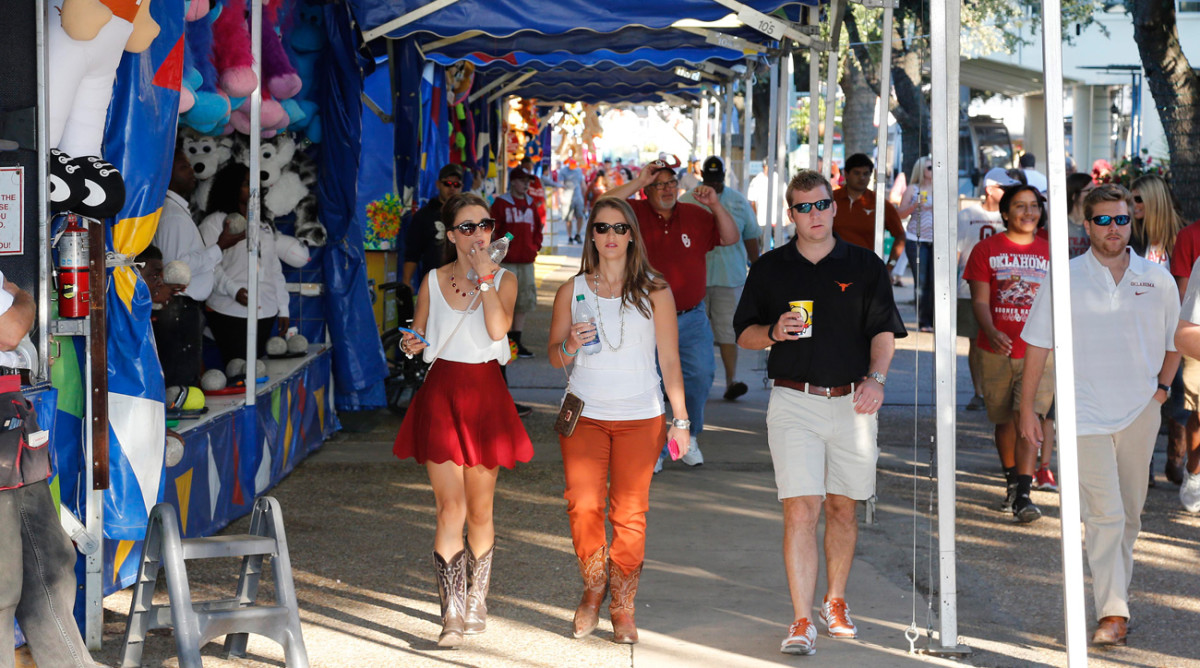Oklahoma-Texas Has Playoff Implications, but Fried Fair Food Never Takes a Backseat to Football


As the story goes, back in 1938, Neil and Carl Fletcher were approached by State Fair of Texas officials with an offer they could have refused, but didn’t. The pitch was to start a food booth, but the Fletcher brothers weren’t chefs, nor did they have experience in the food business. They were actually vaudevillians who had just performed a show called “The Drunkard,” a musical melodrama. But they liked a challenge and decided to figure out some culinary creation to bring to the fair.
Back then, fair food—much less fried fair food—wasn’t a thing. You could buy a square meal, a sandwich, an ice cream cone. That was it. The Fletchers went home that day, opened a bottle of bourbon and brainstormed what would eventually become the most iconic fried fair food of all time.
The corn dog—or more officially, Fletchers’ Original State Fair Corny Dog—was introduced at the State Fair of Texas in 1942. While the batter is a family trade secret, there’s not much to it: a blend of cornmeal, flour, water, salt and sugar creates just the right fluffy texture. Once the mixture is prepared, a hot dog on a stick is dipped into the batter, fried for a few minutes in vegetable oil, and then handed over to the happiest customer. It was a simple idea that’s not only become a culinary tradition in Texas, but ingrained so deeply in the fabric of one of the best sporting events of all time: the Red River Rivalry.
Saturday’s annual Cotton Bowl matchup between No. 6 Oklahoma and No. 11 Texas is the 114th installment of this classic series (it will technically be the 115th meeting between programs after they played for the Big 12 championship for the first time ever last season). While a normal fair day sees some 85,000 people walk through the grounds, vendors on Saturday expect an invasion of at least 200,000 people, 92,000 of which are Texas and Oklahoma fans heading to the game.
Needless to say, corny dog wait time will increase exponentially. If you go to the Fletcher family’s most popular corny dog stall—the one near Big Tex, a.k.a. the world’s tallest cowboy and official greeter of the State Fair of Texas—you could realistically wait more than an hour. While that might give some people pause, it’s always worth it.
“It’s tradition,” says Amber Fletcher, Neil’s granddaughter who’s been working for the family business since she was 10 years old. Her first job was to put the sticks at the end of the wiener. She’s grown up with the company and now focuses on the marketing and operations side. While the Fletchers employ about 200 people during the 24-day fair, 20 of them are family members.
“Fans always need a beer and a corny dog before going to the Cotton Bowl,” she says.
Fletcher says the Texas-OU game—or OU-Texas game, depending on where you’re from—is unquestionably the best day of the fair. It’s unlike any other atmosphere in sports with the stadium split half burnt orange and half crimson and everybody screaming some version of “OU SUCKS” or “TEXAS SUCKS” while waiting for corny dogs, funnel cakes and beer.
“It’s hysterical,” Fletcher says. “We have to tell our employees not to engage with them. ‘You’re Switzerland, OK?’”
When the Fletchers first sold corny dogs in 1942, they made $8,000 over 17 days. This year the family is celebrating its 77th anniversary and expects to sell closer to 600,000 dogs which Fletcher guesses will equate to $4 million. And while they sell about 25,000 wieners on an average fair day, that number soars to 60,000 during the Red River Rivalry.
And it’s not just the Fletchers that feel a lucrative bump. Every concessionaire loves game day.
“Our sales increase by at least 40%,” says Christi Erpillo, who’s family business Winter Family Concessions has been a mainstay at the fair for 50 years. It was her parents who introduced funnel cakes there in 1980. Since then, they’ve created more magical food like fried peaches ‘n cream (an empanada-like pastry filled with orange cake, whipped cream and orange preserves), fried grilled cheese (self-explanatory) and the new burnt end burrito (burnt ends, pepper jack cheese, cream cheese, bacon, Mexican blend cheese, diced jalapeños and BBQ seasoning).
Texas and Oklahoma players and coaches don’t normally get to eat any of this stuff. A Longhorns team official said they board the bus right after the game, win or lose, but a Sooners official said there have been times over the years when players and coaches grabbed fried food with family before heading back to Norman.
While vendors don’t normally show their Texas or OU allegiance that day for fear of retribution, Fletcher and Erpillo agree they make more money if a certain team wins.
“It’s better for business if OU wins,” Erpillo says. “If they lose, they get mad and go home. Texas fans are going to stay and party anyway.”
